Standards for connecting dimensions - sockets and sockets for electric lamps. Screw. Bayonet mounts (= Swan cartridges, bayonet). Mini halogen lamps, tube and spotlights. Fluorescent (luminescent) tubes. Fluorescent lamps.
IN this review The DPVA project describes the connecting dimensions of practically common household and office electric lamps. Connection size has no direct connection with supply voltage, bulb size and power consumption. They need to be specified = clarified separately.
Two types of connection are common:
1) BC = B22d with a diameter of 22 mm with two locking pins. It is used not only in incandescent lamps, but also in low-pressure sodium lamps.
2) SBC = B15d the same, but with a diameter of 15mm. It is used in both incandescent and low voltage halogen lamps.
Screw light bulbs incandescent and "energy saving".

In the world they are known as light bulbs with an Edison Screw =ES connection. This is the most common connection for a light bulb.
Of the ES, the most common socket is E27, with a diameter of 27 mm - a common light bulb in the Russian Federation and throughout the world. E14 = SES = "minion" is the second most common. E12 = CES found on imported and designer chandeliers with a large number of lamps. An even rarer type is E10 = MES; the authors of the project saw them on Christmas tree garlands in childhood.
Type E40 = GES is rarely found in the home, these lamps are mainly used in semi-industrial applications, BUT those who have a street lamp on a pole in their country house or area will immediately remember them. Does not coincide with the extremely similar American type E39 = Mogul Screw with a diameter of 39 mm - written just in case. Sizes E11, E17 and E26 are practically not used in the Russian Federation.
Table: screw incandescent and “energy saving” light bulbs.
| Designation | Diameter | Full English name | British abbreviation |
| E5 | 5 mm | Lilliput Edison Screw | LES |
| E10 | 10 mm | Miniature Edison Screw | MES |
| E12 | 12 mm | Candelabra Edison Screw | CES |
| E14 | 14 mm | Small Edison Screw | SES |
| E27 | 27 mm | Edison Screw | ES |
| E40 | 40 mm | Giant Edison Screw | GES |
Halogen mini bulbs and spotlight tubes.

Miniature halogen encapsulated light bulbs are usually specified by the distance between pins (contacts). It's easy to guess that G4 has 4 mm, etc. Types G4 and GY6.35 are usually intended for low voltage applications, and G9 for 220 V applications.

Most halogen directional light bulbs are mounted on 2 pins (GU4 and GU5.3, where the numbers are the distance between the contacts in mm - this is for low-voltage applications (GU10 or GZ10 10 mm each - this is for 220 V, usually). Attention! between GU10 and GZ10 there is significant difference. The GU10 has a chamfer around the leg, while the GZ10 has a straight angle. Thus, GZ10 cannot be used in a GU10 holder, but GU10 can be installed in both holders.

Most of these lamps have a “two pin” connection - two contacts on each side of the lamp.
Standard tube sizes T8 (25mm diameter) and T12 (38mm diameter) both have a G13 - 13mm connection between pins.
Less common T5 tubes (16mm diameter) have a G5 - 5mm connection between the pins.
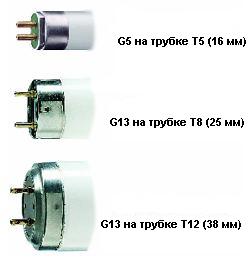
Additional information for the review of fluorescent (luminescent) tubes.

The very thin T2 tube (7mm diameter) has a W4.3 female connector with 4.3mm spacing between the T2 tubes holes.

T4 tubes (12mm diameter) have a G5 connector with 5mm pin spacing.
Incandescent lamps - "daylight"

These lamps usually have one of two possible connections: S14s, mounted at one end of the lamp, or type S14d, mounted in the center of the lamp.
Traditional (museum) incandescent "daylight" lamps usually have a 15mm diameter S15s connection at both ends of the lamp.

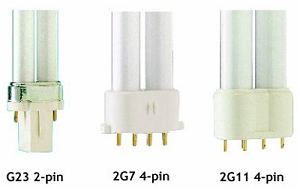
Double pipe compact fluorescent (fluorescent) lamps= two tubes with gas.
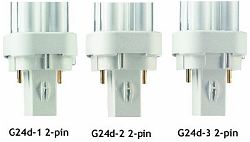
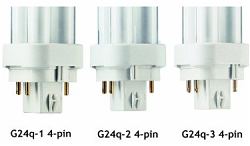
After purchasing a chandelier or lamp, many are faced with the problem that there are no lamps with more than 500 Lumens for the E14 base.
People come to me with this problem quite often, asking where to buy powerful E14 LED lamps in the form of a candle or a candle in the wind. Most of those who applied did not want to install energy-saving ones, so I could not advise anything good. A month ago, a solution from the X-Flash company appeared at 820 Lumens, which we will test. In addition, X-Flash has the most advanced lighting technology with new types of dimming and light control, smart technologies for Smart Houses.
- 1. Characteristics
- 2. Comparison with minions
- 3. Service life
- 4. Dimensions
- 5. Model range
- 6. Design
- 7. Filling
- 8. Dimming
- 9.Power
- 10. Luminous flux
- 11. Heating
- 12. Light ripple factor
- 13. Driver
- 14. Color temperature
- 15. Angle of glow in the dark
- 16. Mass
- 17. Packaging
- 18. Pros and cons of the product
Characteristics

The review includes an E14 LED bulb with the designation “X-Flash XF-E14-TC-P-10W-4000K-220V”. This type of base is also called a minion; the diameter of the base is 14mm. And for E27 it will be 27mm. respectively.
| Declared | Measured | |
| Power | 10W | 8.9W |
| Luminous flux | 820lm | 856lm |
| Nutrition | 85 – 265V | |
| Ripple factor | less than 1% | 1,3% |
| Color temperature | 4000K | 4090K |
| Dimensions | 112x38mm. | 110x38mm. |
| Base | E14 | |
| Incandescent analogue | 75W | 75W |
| Dimming | No | |
| Color rendering index | CRI 80 | CRI 84 |
| Service life | 50,000 hours | |
| Ambient temperature | -30° to +50° | |
| Price as of 04/15/2016 | 349 RUR | |
| Guarantee | 5 years |
The table shows the correspondence between power and Lumen. The tested model at 856lm is slightly superior to its 75W counterpart at 800lm.
Important. Replacement under warranty usually takes place using a sales receipt, sales receipt usually they don't take it. Cash receipt, printed on thermal paper, fades after 2 years and becomes unreadable. That is, it will not be possible to exchange a faulty product for a new one. Therefore, require filling out a passport for each with signatures and dates. Sellers fill them out very rarely.

Comparison with minions
The photo shows other E14 LED lamps, comparison from left to right:
- X-Flash is almost a candle, only rectangular;
- cheap Chinese corn;
- Feron candle 3W;
- ball ASD G45 at 5W;
- Philips G45 at 60W.
Philips is 30% weaker, the rest shine 2-3 times worse.
Corn and energy saving
An alternative is energy-saving lamps; the energy-saving lamp in the photo will be similar to 60 W. But now small rubber balls are sold everywhere that bounce well off the ceiling, walls and floor. Children use these balls to easily break energy-saving lamps and chandeliers in the apartment.
There are many more comparisons:
- diode R39, for spots they are mirrored;
- candle in the wind, filament;
- X-Flash E14;
- filament candle in the wind;
- transparent candle on filament diodes.
Over the past six months, good LED lamp Many manufacturers tried to make E14, for example Ecola, Camelion, Gauss, Genieled. Design limitations are associated with the small size of the minion body. But they didn’t achieve anything worthy, they reached a maximum of 600lm, and this is not enough for a lamp with 3-5 cartridges. Many people began to think about good lighting in an apartment or house, especially feeling the difference between incandescent light bulbs and LEDs. Once upon a time I also had a similar transition process; I’ve been experimenting with lighting for 5 years. Most buyers do not know the standards and do not have lux meters. I usually recommend illuminance of 200 Lux, and use the simplest calculation depending on the area of the room.
Service life

The actual service life can be indirectly determined by the manufacturer's warranty on the product. For Chinese consumer goods, for example the ASD company, it takes 1-2 years due to low quality. In our case, X-Flash gives 5 years, that's 60 months, or 43,000 hours of continuous operation. Almost corresponds to the declared operating time of 50,000 hours. If the manufacturer is not confident in the quality of its lighting equipment, then there will be large losses due to the costs of warranty exchange.
Dimensions
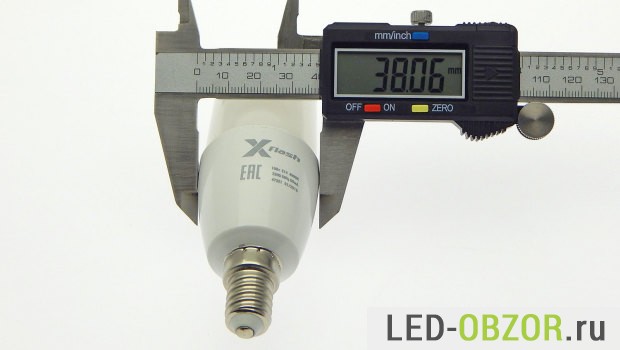

Model range
The tested samples differ from all others in their shape. They will not be able to replace the minion R39 and R50 due to the increased diameter; they will be suitable to replace the standard ones in the form of a candle and a candle in the wind E14. They are often installed in narrow lamp shades, where a spherical or reflective R39 R50 will not fit or will be difficult to screw in. Sometimes they also look for a 100 W analog; the tested model is closest to it.
Main types:
- power is the same 10W;
- color temperature 3000K and 4000K;
- There are models with dimming, marked with a dimmer icon;
- the price as of April 15, 2016 is 499 rubles.
Design

Structurally, the sample is made according to the popular design, a closed radiator and a matte flask. To remove the diffuser, you need to insert a thin and rigid one at the point of attachment to the body and move it in a circle. A white adhesive-sealant is applied along the edge, thanks to which presentation It doesn’t get lost and there’s no need to break anything.
The assembly turned out to be of very high quality; the sample stubbornly resisted disassembly. Even after unscrewing the bolts securing the plate with LEDs to the radiator, the LED module was firmly attached to the thermal paste. As a result, one of the LED chips was damaged.
The cooling system used is the best for household diode light bulbs. The aluminum cylinder is covered with heat-conducting plastic to avoid burns. That is, the entire body is a solid radiator. Cheap consumer goods simply have an aluminum plate inserted inside, which is separated from it by an air gap.
On one side, a cover is pressed into the cylinder, onto which LED diodes are attached. There was no way to get it out; it was starting to bend. I had to cut down the base and then make a cut along the product.
Filling

This model uses 14 LEDs in a 0.5W format. The most popular power for 2835 is 0.2W, but this is just a designation for the case; any crystal can be installed, from Chinese at 0.05W to branded at 1W. This diode model has 2 crystals installed, this can be seen under the phosphor. It was not possible to take a decent photo of the crystals; you need a lens for macro photography.
Dimming
Dimming is not supported in this model, but there are exactly the same E14 LED lamps with dimmer support. But they cost more: 499 rubles.
Power
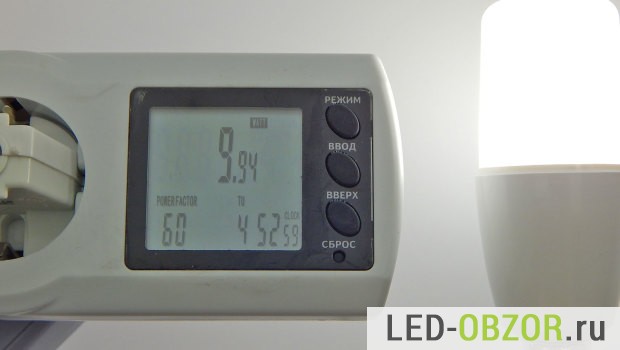
Let's check the energy consumption with a calibrated wattmeter.
After 30 minutes of operation, consumption dropped to 8.9W, while the luminous flux corresponds to the promised one. We put 1 more plus sign, energy consumption is lower, and the light shines as promised.
Luminous flux
To measure the luminous flux, we warm up LED lamp with E14 base for 60 minutes. We also measure the number of lumens without a diffuser. If conditions permit, it can be removed and the brightness increased if the light is directed towards the ceiling.
We multiply the light meter readings by 10 and divide by a factor of 2.16 to get Lumens.
According to the data obtained, it turns out that the number of Lumens is 4.3% more. Exceeding the promised parameters occurs only with good lighting equipment; usually manufacturers deceive by 10-20% for the worse.
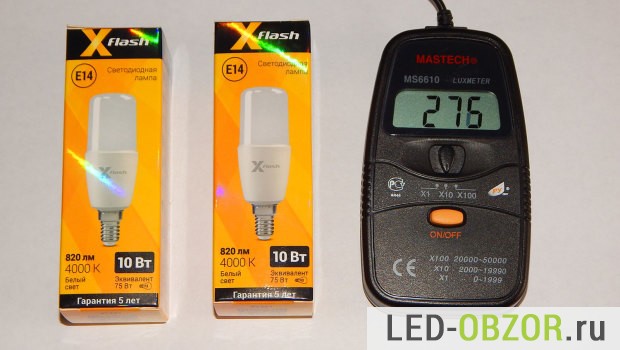

Heat
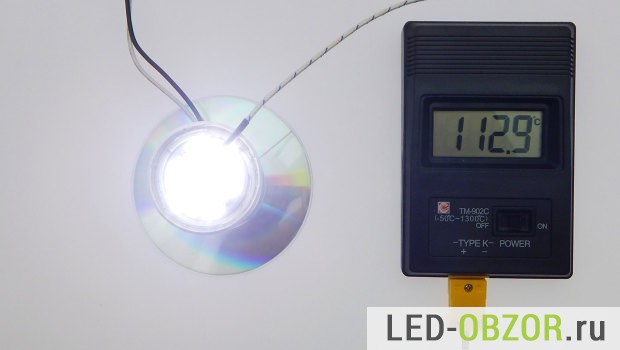
To measure the heating of the LEDs and the housing, I will use an infrared pyrometer and a temperature sensor (thermocouple). Pre-worked for 1 hour.
The matte diffuser has a slight effect (only 3.5°) on the heating of the LEDs, which indicates high-quality heat dissipation.

Light ripple factor

The packaging says that there are no pulsations, that is, they should be about 1-2%, taking into account the error of the Radex Lupin device. This figure corresponds to the promised 1% from the manufacturer. An incandescent light bulb usually has a ripple of 15-17%.
Driver

The current source is assembled on a BP2832A chip. The ripple coefficient is zero, which means it fully performs its functions.


Weight
Package
Pros and cons of the product
The LED lamp E14 candle from X-Flash XF-E14-TC-P-10W-4000K-220V turned out to be very good, it has no worthy competitors. Refers to the C37 format, and will replace the spherical R50 and reflective R50. The power will be analogous from 60 W, and almost up to 100 W, due to the color of 4000 Kelvin.
Main advantages:
- small dimensions;
- does not overheat;
- the number of lumens corresponds to the declared ones;
- lower power is a plus, the less the better.
The final cost of operation will be lower than that of consumer goods. That is, 1 piece from X-Flash for 349 rubles. will replace you with 3 consumer goods of similar capacity for 150 rubles each. Cheap ones use various tricks and deception to hide their real characteristics and appear to be of high quality.
Often, when choosing a light bulb, a person does not remember its main characteristics. Moreover, many buyers shake their heads in bewilderment when asked by the seller about the right base. This article will talk about existing types plinths.
The information below will help you do right choice light bulbs.
Base E14
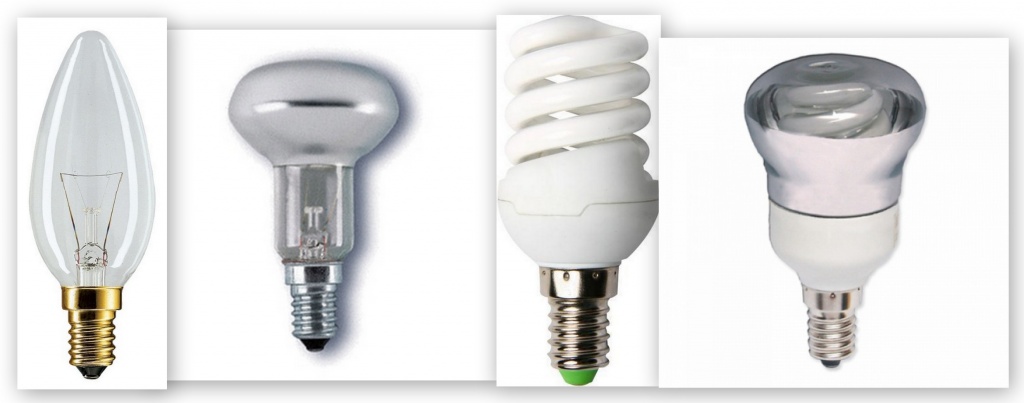
Is one of the most common. The number 14 in the name is the diameter in mm. The common name for the E14 base is “minion”. Today, this type of base is widespread among diode and compact energy-saving lamps - the variety of their light and color characteristics, shapes, provides a large number of options for designing lighting in a building and room. As for traditional incandescent lamps with E14 base, they can be made in both classic and candle-shaped forms.
Base E27

The most popular type of base, invented by Edison. It is used in traditional incandescent lamps, halogen and compact energy-saving lamps, diode and gas-discharge lamps, etc. However, it should be taken into account that compact energy-saving lamps with an E27 base cannot be used with electronic switches or dimmers.
Base E40

The largest base in group “E”. Today they are equipped with economical and mercury lamps, powerful incandescent lamps, sodium and metal halide lamps, designed for lighting large areas - highways, squares, squares, streets, roads.
Base G4

Created for halogen lamps (mainly for voltage 12 V), which have miniature dimensions and bright point radiation, which makes them widely used in decorative design residential premises. The main advantage of such lamps is their miniature size, compatibility with compact ceiling lamps. The operating period of halogen lamps with a G4 base reaches 2 thousand hours.
Base G5

Used for installing fluorescent lamps with a bulb thickness of 16 mm. Lamps of this type are characterized by low energy consumption, high output and quality of light - from cold daylight to warm white. All this contributes to their high popularity.
Base G9

Miniature halogen lamps with this type of base are used for finishing chandeliers and decorative lamps in a 220 V network. The shape of the lamp bulb resembles a capsule; it can be matte or transparent. Halogen lamps with G9 base they work without transformers.
Base G13

Used for installing linear classic T8 fluorescent lamps with a bulb diameter of 26 mm. Lamps of this type used as lighting sources inside buildings and premises or for external lighting territory (if the lamp has appropriate protection). Fluorescent lamps with a G13 base are characterized by a long service life, efficiency, and a large lighting area. They are used in combination with ballasts, electronic or electromagnetic devices.
Base G23

Used in compact fluorescent lamps with a bulb shape resembling the letter “U”. Most often this table lamps. A starter is located inside the base; the lamp is started using an electromagnetic choke. The power of such lamps ranges from 5-14 W.
Base G24
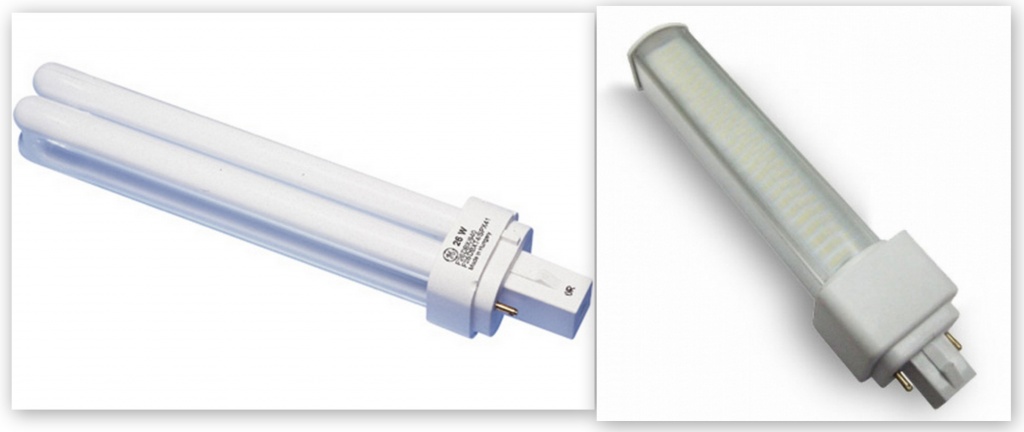
Lamps with a G24 socket are similar to lamps with a G23 socket. The only difference is in the shape of the flask - it is folded in four (2U). The G24 base is used in table and small-sized lamps.
Base G5.3

It is used in miniature halogen lamps and lamps with reflectors intended for decorative lighting of interiors. The dimensions of such lamps contribute to their widespread use for accent light in show windows of exhibitions, stands, shops, as well as indoor light sources in small ceiling lamps.
Base G10

Used in diode, halogen, energy-saving lamps for installation in decorative spotlights and certain types of wall lamps operating on a 220 W network. The luminaire is mounted by means of a rotary type connection with the lamp socket.
Base G6.35

Used in halogen capsule lamps for installation in tabletop and wall lamps, decorative spotlights. The pin-type base is similar to the GU 5.35 and G4 mentioned above, but the contacts are located at a distance of 6.35 mm.
Base R7S

Used in halogen linear lamps, widely used in household, industrial and commercial areas, and in small-sized floodlights. Halogen linear lamps differ from traditional incandescent lamps in better color rendering and increased light output (20-25%). They work in a 220 V network and only in lamps with protective glass.





